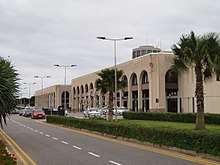Transport in Malta
The transport system in Malta is small but extensive, and the islands' domestic system of public transport is reliant on buses and taxis, although there were both a railway and a tramway in the past.
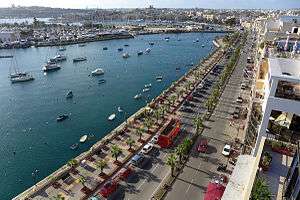
Malta's primary international connections are the airport at Gudja and by sea mainly the Grand Harbour, and the Malta Freeport (the 3rd largest transshipment port in the Mediterranean Sea).
Land transport
Roads
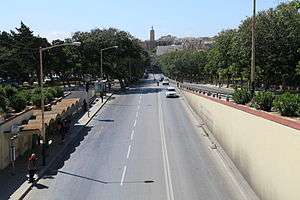
Traffic in Malta drives on the left, as in the UK. Car ownership in Malta is exceedingly high given the very small size of the islands. The country has a car ownership rate of 766 motor vehicles per 1,000 people.[1] As of 2020, the number of registered cars amounted to 394,955, giving an auto-mobile density of 1253.8 per km².
Malta has 3,096 kilometres of road, 2,704 km (87.3%) of which are paved and 392 km are unpaved as of 2008.[2]
The official road user guide for Malta is The Highway Code.[3]
Buses
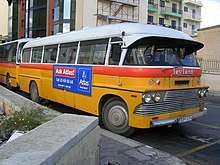
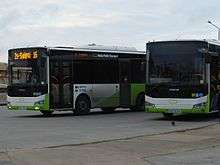
Buses are the primary method of public transport for the Maltese Islands and have been in operation there since 1905, offering a cheap and frequent service to many parts of Malta and Gozo. The vast majority of buses on Malta depart from a terminus in Valletta. Malta's buses carried over 40 million passengers in 2015.[4]
The traditional classic Maltese buses, which were in operation until 2011 and still provide tourist-oriented services to this day, have become visitor attractions in their own right due to their uniqueness, and are depicted on many Maltese advertisements to promote tourism as well as on gifts and merchandise for tourists. Prior to their reform there were approximately 500 buses in public transit service, most of them privately owned by the bus drivers themselves, and operated to a unified timetable set by the transport authority. On any one day, half the bus fleet worked on the public transport network (called "route buses"), while the other half were used for private tours and school transport.
In July 2011 a new public transport network was installed by Transport Malta (the regulating authority) and on 3 July 2011 it started being operated by Arriva Malta, which was 66% owned by Arriva Group (owned by German company Deutsche Bahn and 33% owned by Malta's Tumas Group), operating as the sole operator on a 10-year contract and running a new 264-strong fleet of buses in a turquoise and cream livery. Unlike the system it replaced, the buses were owned and operated by a single company with the drivers working as employees of Arriva Malta.
When Arriva ceased operations on 1 January 2014 due to financial difficulties, the company was nationalised as Malta Public Transport by the Maltese government as an interim measure while a new bus operator could be found.[5][6] As of October 2014 the government has chosen Autobuses Urbanos de León as its preferred bus operator for the country, and although the agreement has yet to be fully determined and signed, it is planned that they will being operation in January 2015.[7]
During the closing days of December 2014, the Times of Malta and other newspapers were reporting that the company had now signed contracts and purchased the existing operation for 8 million euros.[8][9] They duly took over the business on January 8, 2015 with their takeover being effected as a "soft launch". The existing name - Malta Public Transport - is to be retained instead of using Autobuses Urbanos de León and nothing will have changed from a passenger perspective initially. The buses are to be repainted into a new livery of light green and white and during a press announcement to mark the formal takeover of operations on the day, several repainted buses were lined up for a photo call to show off the new livery, these being two of the leased in 2014 Optare Solos, one of the leased in 2014 Wright Volvos, one each of the new in 2011 King Long XMQ6900J and XMQ6127J buses. By February the sub contracted buses from UBS were replaced - temporarily - with 32 dual-door Mercedes-Benz Citaro[10] buses operated by ALESA (as opposed to the situation until then of sub contracting of both bus and driver from UBS) until new Otokar Vectio C dual-door single deck buses currently on order[11] have arrive later in 2015. These new buses will number 142 in total and used to augment the existing fleet as the revised route network is incrementally rolled out during the course of 2015 with the full service planned not expected to be fully realized until 2016, at which time the 23 million euro subsidy for 2015 will rise to 29 million thereafter.[12]
In January 2019, the Government has said that young people who are between 16 and 20-years old in 2018 can now travel by bus for free. People between 17 and 19-years old will travel for free between the 1st of January 2019 and the 31st of December 2019. The government also said that those who will turn 16 this year, will start travelling for free on their birthday and will keep benefiting from the scheme until their 17th birthday. 20-year olds will benefit until they reach 21.[13]
Maritime transport

_06_ies.jpg)
Malta has three large natural harbours on its main island. There are also two man-made harbours that connect the islands of Malta and Gozo.
- The Grand Harbour, located at the eastern side of the capital city of Valletta. The Grand Harbour, which has been used as a harbour since Roman times, has several extensive docks and wharves, as well as a cruise liner terminal.
- Marsamxett Harbour, located on the western side of Valletta, accommodate a number of yacht marinas.
- Marsaxlokk Harbour is sited at Marsaxlokk on the southeastern side of Malta, and is the location of the Malta Freeport, the islands' main cargo terminal.
Ferry services
A frequent daily passenger and car ferry service runs between the islands of Malta and Gozo between Ċirkewwa Harbour and Mġarr Harbour.
There is also a ferry terminal at the Grand Harbour that connects Malta to Pozzallo and Catania in Sicily.
Air transport
.jpg)
Malta International Airport is the only airport serving the Maltese Islands. It is built on the land formerly occupied by the RAF Luqa air base. A heliport is also located there, but the scheduled service to Gozo ceased in 2006. From June 2007 to August 2012, a three-times daily floatplane service, operated by HarbourAir Malta, linked the sea terminal in Grand Harbour to Mgarr harbour in Gozo.[15]
In the past there were two further airfields which were in operation during World War II and into the 1960s, located at Ta'Qali and Ħal Far. They have now since been closed, the land on the former has now been converted into a national park, stadium and the Crafts Village visitor attraction. The Malta Aviation Museum is also situated here, preserving several aircraft including Hurricane and Spitfire fighters which defended the island in World War II. Ħal Far has been converted into an industrial estate, a race track and an immigration reception centre.
The national airline is Air Malta.
Transport Malta
With its creation in 2010, the Authority for Transport in Malta, or Transport Malta,[16] assumed the functions of the Malta Maritime Authority, the Malta Transport Authority and the Director and Directorate of Civil Aviation on 2010.[17]
Malta Transport Museum
The Ministry of Culture of Malta sanctioned Touring Club Malta to set up a Transport Museum.[18]
References
- "Malta's Vehicle Population Reaches 400,000 With 73 New Cars On The Road Each Day". Lovin Malta. 28 October 2020. Retrieved 8 August 2020.
- "CIA World Factbook - Malta". Central Intelligence Agency. Retrieved 26 October 2014.
- "Land Transport". Government of Malta. Retrieved 26 October 2014.
- "Bus passengers increase by 20 per cent since introduction of card system".
- "Arriva Future Decided". di-ve.com news. 22 November 2013. Retrieved 26 October 2014.
- Sansone, Kurt (23 December 2013). "New Year in, Arriva out". Times of Malta. Retrieved 26 October 2014.
- Dalli, Kim (1 October 2014). "New bus operator to start in January". Times of Malta. Retrieved 26 October 2014.
- "Update 3: New public transport provider to take over bus service on January 8". Times of Malta. Retrieved 12 June 2015.
- "Spanish public transport operators to take over on January 8". MaltaToday.com.mt. Retrieved 12 June 2015.
- "Update 2: Malta Public Transport says there will be no disruptions in public transport". Times of Malta. Retrieved 12 June 2015.
- "First order of RHD buses to Otokar". Retrieved 12 June 2015.
- "Spanish company takes over bus service". Times of Malta. Retrieved 12 June 2015.
- Ltd, Allied Newspapers. "Aged 16 to 20? Hop on the free public transport bus". Times of Malta. Retrieved 2019-01-14.
- "Record tonnage registered in Malta shipping register". Times of Malta. 11 February 2016. Retrieved 27 November 2018.
- Barry, Duncan (16 August 2012). "Harbour Air halted seaplane service for the summer". Malta Today. Retrieved 26 October 2014.
- "Transport Malta". Retrieved 23 January 2017.
- "CHAPTER 499 AUTHORITY FOR TRANSPORT IN MALTA ACT". Malta Ministry of Justice. Retrieved 23 January 2017.
- Camilleri, Joseph C. (12 August 2006). "Ix-xewqa ta' Philip Agius... Muzew tat-Transport". It-Torċa.
Notes
- Bonnici Calì, Rafel (June 1978). "Folklor fuq il-Karozzi tan-Nar" (PDF). L-Imnara (in Maltese). Rivista tal-Għaqda Maltija tal-Folklor. 1 (1): 13–17.
- Ganado, Albert (2005). "Bibliographical notes on Melitensia - 3". Journal of the Malta Historical Society. Melita Historica. 14 (2): 173–174, see footnote 8. Archived from the original on 21 April 2014.
External links
| Wikimedia Commons has media related to Transport in Malta. |
